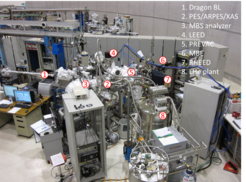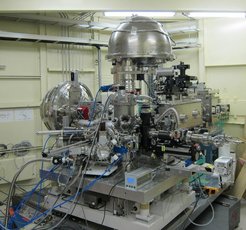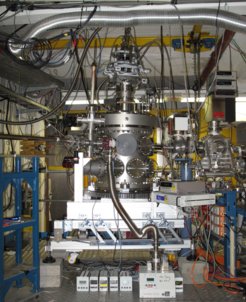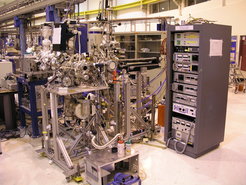X-ray Spectroscopies
1) Angle-Resolved PhotoEmission Spectroscopy (ARPES)
The MPI CPfS end station in NSRRC is capable of performing photoemission spectroscopy (PES), angle-resolved photoemission spectroscopy (ARPES), and X-ray absorption spectroscopy (XAS) experiments. The spectrometer mainly consists of a MBS hemispherical analyzer with a 2D-CCD detector. The MBS spectrometer has a mean radius of 200 mm with 9 changeable slit sets (aperture and object slits). The energy resolution of the analyzer is better than 1 meV. The angular resolution is smaller than 0.1o. The MBS 2D-CCD detector has a wide-angle span of ±20o, which covers the first Brillouin Zone of most of interesting oxides. A five-axis (X,Y,Z,Q,Y) manipulator is equipped and the sample stage can be cooled down to 10 K.
A versatile in-vacuum transferring and sample preparation system is equipped. The main piece is a PREVAC transferring system. Satellite chambers are equipped with a LEED, an ion sputtering gun, and e-beam heaters for surface science characterization and preparation. A molecular-beam-epitaxy (MBE) film growth facility can also be docked onto the PREVAC transferring system for in-vacuo thin film projects.

2) Hard X-ray PhotoEmission Spectroscopy (HAXPES)
Our experimental work is performed at the SPring-8 synchrotron radiation facility (Japan). A sideline of Beamline BL12XU (Taiwan Beamline) is dedicated to the joint HAXPES project of MPI CPfS and NSRRC. The new end-station, designed by MPI CPfS, is equipped with two analyzers (A-1HE from MB Scientific) mounted perpendicular and parallel to the polarization of the incoming beam allowing to use the polarization dependence of the differential photoionization cross section for the different orbitals (i.e. s, p, d, etc.) to enhance the orbital contribution of interest. This makes the instrument unique in the world. Samples are mounted on an xyzθ manipulation stage which is —as well as the table on which the whole setup is placed— fully motorized to allow a fine tuning of the sample position while the beam is on. A flow cryostat is used to cool the sample with liquid nitrogen or liquid helium. A separate preparation chamber is used for sample transfer and storage and for in situ cleaving.

3) Resonant X-ray Scattering (RXS)
The UHV diffractometer end station, jointly designed with Dr. Christian Schüßler-Langeheine, is capable of performing resonant x-ray scattering as well as coherent diffraction experiments. The main part is a two-circle diffractometer with independent sample and detector rotations in horizontal scattering geometry. The sample to detector distance can be up to 192 mm. A fully motorized four-axis (X,Y,Z,Chi) manipulator is equipped and the sample stage can be cooled down to 10 K. Two types of detectors are installed. One is an aluminum coated silicon photo diode with a set of slits (0.5, 1,2 4 mm) in the front, which can be changed in vacuum. The other is an in-vacuum CCD camera from Princeton Instruments.

4) Non-resonant Inelastic X-ray Scattering (NIXS)
5) X-ray absorption spectroscopy (XAS)
The combined experimental and theoretical X-ray absorption linear dichroism (XLD) and circurlar dichroism (XMCD) study on the bulk materials and thin films of transition metal compounds, which have interesting macroscopic properties, such as metal-insulator transition (MIT), colossal magneto-resistance (CMR), superconductivity, magnetic phase transition, multiferroics.




